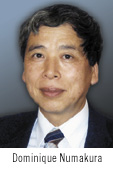
A further recap of the recent JPCA Show.
Several years ago, the PCB industry experienced a boom with LDI (laser direct imaging) technology. At least four companies displayed newly developed LDIs at IPC Expo. Photoresist suppliers developed high sensitivity (and expensive) dry-films, and manufacturers leaned toward LDI processing as the solution for next-generation HDI boards.
LDI was recommended for its resolution, double-side capabilities, ability to accomodate design changes, processing speeds and total manufacturing cost. And while LDI is a great choice for process flexibility, I question its use in other applications because of bad experiences with direct imaging technology in semiconductor processes. Customers agreed. It was actually the customers, or lack of customers, that made the truth known. With the exception of Orbotech, just about all the LDI equipment and materials manufacturers disappeared from the market within a few years.
Today, Japanese equipment manufacturers are developing LDI machines based on practical concepts. At least five companies - Orbotech, Pentax, Fuji Films, Dai-Nippon Screen and Hitachi Via Mechanics - displayed LDI equipment at the JPCA Show this year. Prototype and multilayer board manufacturers explained they are focusing features of the LDI process on its flexibility and quickturn capabilities.
The newly developed LDI machines are much more advanced. The differences of the resolution and productivity are very clear. Today's manufacturers shared many success stories involving quickturn productions and build-up process with dimensional corrections. It's obvious that fabricators can improve productivity and process yields significantly with today's LDI technology.
I am concerned, however, that there are too many LDI machine vendors for the industry to support. Pentax, for example, announced that their LDI business would be sold to ORC after the show. Time will tell the fate of the other companies.
Japanese material suppliers were well represented throughout the JPCA Show. I did not observe any innovative ideas or materials, although overall improvement was noted. Laminates with ultra-thin copper foils and carrier sheets were prevalent, and many manufacturers could be heard saying "thinner" and "finer."
Ultra thin copper foil with carrier sheets is not a new idea. Most copper foil suppliers rolled out 1 to 5 µm thick ED copper foils supported by other copper foils several years ago. Unfortunately for these suppliers, copper laminate manufacturers did not pay much attention to ultra thin foils at that time. This year, many manufacturers, including those of flexible materials, displayed samples of thin copper laminates.
A common topic for discussion during the exhibition dealt with the EU RoHS regulations. Lead-free soldering is not a big issue for material suppliers, provided their products can survive a (somewhat) higher soldering temperature. Japanese board manufacturers have already phased out hot-air leveling as the surface treatment; therefore, their suppliers will not have to worry.
The halogen-free regulation is a bigger issue. All the material suppliers presented halogen-free materials and stated they have at least the performance equivalent of traditional materials with bromine-included materials. Customers have evaluated the materials, they said, and suppliers are ready for volume production. Board manufacturers also declared their readiness to produce halogen-free boards. They said end-customers are evaluating halogen-free boards; however, very few companies are currently in volume production with the materials.
The new halogen-free materials come at a relatively higher price because of the additional R&D costs. But no one wants to bear the additional costs of the materials in such a price competitive market. Once volume production begins with the new halogen-free materials, competitors and other manufacturers will follow. Right now, most companies are observing the activities of other manufacturers before determining their courses of action.
Headlines
PCB maker Toppan-NEC Circuit Solution estimates its IC substrate business will grow 400% to 10 billion yen in 2006. High pin count flip chip substrates will be the major products.
PCB maker CMK will invest 12 billion yen to build a manufacturing plant of build-up boards in Thailand. It is scheduled to begin operation in April 2007.
TOK, a major photoresist supplier in Japan, will invest 1.8 billion yen to build a R&D building for the next-generation photoresists for LCD and PDP manufacturing.
Toppan Printing, a major printing company in Japan, has developed a low-cost printing process for the manufacture of large-sized full-color organic EL display.
Mitsubishi Gas Chemical, a major PCB material supplier in Japan, will increase prices of copper laminates and prepregs 10 to 25% due to increased cost of raw materials.
Sumitomo Bakelite unveiled its business plan, saying in the next two years it will commercialize several new FR-4 and SEM-3 products.
Hitachi Chemical expects 10% revenue growth in 2006. Its new thin laminate targets the niche market between thin rigid boards and flexible circuits. PCD&M
Dominique Numakura is president of DKN Research; This email address is being protected from spambots. You need JavaScript enabled to view it..














